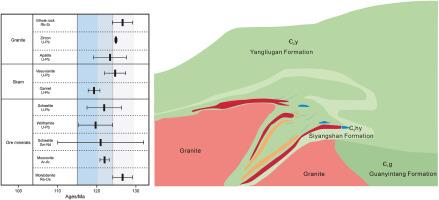Tectonic settings and geochronological evolution of the Xianglushan skarn tungsten deposit, Jiangnan orogenic belt: A multi-mineral age dating approach
IF 3.4
3区 地球科学
Q1 GEOCHEMISTRY & GEOPHYSICS
引用次数: 0
Abstract
The Jiangnan tungsten ore belt (JOB) in South China, recognized as a global significant tungsten metallogenic belt, hosts numerous economically significant skarn-type and quartz vein-type tungsten deposits. The Xianglushan tungsten deposit, a reduced skarn system dominated by scheelite mineralization, provides critical insights into regional ore-forming processes. Precise geochronological constraints are pivotal for deciphering the metallogenic evolution. In this study, we employ high-resolution laser ablation-inductively coupled plasma-mass spectrometry (LA-ICP-MS) U–Pb geochronology to analyze zircon, apatite, garnet, vesuvianite, wolframite, and scheelite from this deposit. Zircon yields Late Yanshanian U–Pb ages of 124.7 ± 1.6 Ma and 126.5 ± 0.5 Ma, while apatite records 126.4 ± 5.2 Ma. Metasomatic phases, including vesuvianite (124.2 ± 1.7 Ma) and garnet (119.3 ± 2.1 Ma), exhibit distinct age populations. Hydrothermal ore minerals demonstrate younger crystallization ages, with wolframite at 120.7 ± 4.1 Ma and scheelite at 121.6 ± 4.1 Ma. The progressive age distribution, from granite to prograde skarn silicates and retrograde ore minerals, reveals a prolonged, multistage mineralization history spanning ca. 7 Myr. Integrating geochronological data with regional tectonic evolution, we propose that the Xianglushan tungsten system formed during Late Mesozoic lithospheric extension, triggered by the rollback of the subducting Paleo-Pacific Plate beneath the South China Block.

江南造山带象庐山夕卡岩钨矿床的构造背景与年代学演化:多矿物年代测年方法
华南江南钨矿带(JOB)是公认的全球重要的钨成矿带,拥有大量具有经济意义的矽卡岩型和石英脉型钨矿床。象庐山钨矿床是一个以白钨矿化为主的还原夕卡岩体系,为研究区域成矿过程提供了重要依据。精确的地质年代学约束是破译成矿演化的关键。在本研究中,我们采用高分辨率激光烧蚀-电感耦合等离子体质谱(LA-ICP-MS) U-Pb年代学方法分析了该矿床中的锆石、磷灰石、石榴石、维苏岩、黑钨矿和白钨矿。锆石的U-Pb年龄分别为124.7±1.6 Ma和126.5±0.5 Ma,磷灰石的U-Pb年龄为126.4±5.2 Ma。交代相包括维苏岩(124.2±1.7 Ma)和石榴石(119.3±2.1 Ma),表现出不同的年龄群。热液矿石的结晶年龄较低,黑钨矿为120.7±4.1 Ma,白钨矿为121.6±4.1 Ma。从花岗岩到进行矽卡岩硅酸盐和逆行矿石矿物的年龄分布,揭示了一个长时间的多期成矿史,跨度约7 Myr。综合地质年代学资料和区域构造演化,我们认为香山钨系形成于晚中生代岩石圈伸展时期,由华南地块下俯冲的古太平洋板块的回退所引发。
本文章由计算机程序翻译,如有差异,请以英文原文为准。
求助全文
约1分钟内获得全文
求助全文
来源期刊

Applied Geochemistry
地学-地球化学与地球物理
CiteScore
6.10
自引率
8.80%
发文量
272
审稿时长
65 days
期刊介绍:
Applied Geochemistry is an international journal devoted to publication of original research papers, rapid research communications and selected review papers in geochemistry and urban geochemistry which have some practical application to an aspect of human endeavour, such as the preservation of the environment, health, waste disposal and the search for resources. Papers on applications of inorganic, organic and isotope geochemistry and geochemical processes are therefore welcome provided they meet the main criterion. Spatial and temporal monitoring case studies are only of interest to our international readership if they present new ideas of broad application.
Topics covered include: (1) Environmental geochemistry (including natural and anthropogenic aspects, and protection and remediation strategies); (2) Hydrogeochemistry (surface and groundwater); (3) Medical (urban) geochemistry; (4) The search for energy resources (in particular unconventional oil and gas or emerging metal resources); (5) Energy exploitation (in particular geothermal energy and CCS); (6) Upgrading of energy and mineral resources where there is a direct geochemical application; and (7) Waste disposal, including nuclear waste disposal.
 求助内容:
求助内容: 应助结果提醒方式:
应助结果提醒方式:


